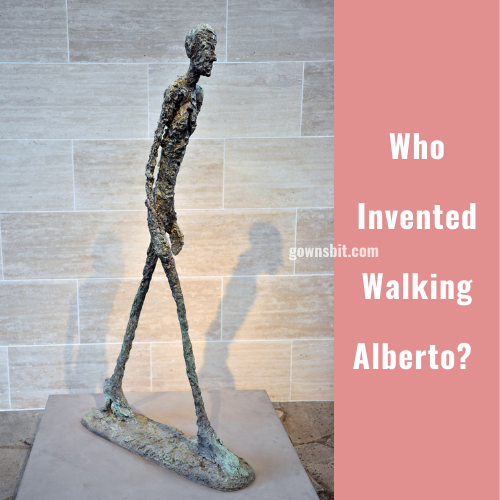Walking Alberto is a very creative sculpture and people want to know Who invented walking Alberto. So it was invented by Alberto Giacometti. Alberto was born into a Swiss family of notable artists. In 1947, he entered the field of producing expressionist sculptures and soon he became famous as a creative sculpture artist. The sculptures that he made are very thin and well-defined. He was born on October 10, 1901.
He is a famous Swiss painter, draftsman, and sculptor. Alberto was one of the most famous sculptors of the 20th century. His sculptures show great expressions of philosophy and existentialism. In 1935, he started working on sculpture and figurative compositions. At the start of his career, he made small sketches of 5 to 7 centimeters. But after World War 2, he started making Tall and Slender figures.
During World War 2, Alberto took refuge in Switzerland, and there he met Annette Arm, a secretary for the Red Cross. They got married in 1949. After their marriage to Alberto, they started making large sculptures. His sculptures were not only large but thin too. His famous sculpture depicting a walking man earned him a lot of success and fame. He made sculptures to present people in motion.
Table of Contents
Who invented walking Alberto?
Alberto was a Swiss national who is famous for his artistic sculptures. He is the inventor of walking Alberto. Alberto’s works can be seen in the collections of the Arts Institute of Chicago, the Museum of Modern Art, the National Gallery of Art, the Kunstmuseum Basil, the Guggenheim Museum, and the Tate.
His sculptures have been sold for almost a hundred million dollars in the market. His work was particularly influenced by artistic styles like Cubism and Surrealism. Philosophical domains like the human condition and existential and phenomenological debates had a lot of influence on his work.
An interesting fact about Alberto is that he paid very less attention to the painting part of his sculptures. In the times of 1930s and 1940s, he worked on sculptures of very less heights than 7 cm. This less height depicted the relationship between the artist’s position and his project. But after World War 2, he started making large and thin sculptures.
What is the structure of Walking Alberto?
It is the name of any bronze sculpture that consists of 6 editions and 4 artist proofs designed by Swiss sculptor Alberto Giacometti in 1961. The second edition of the sculpture became one of the most expensive works of art. On 3 Feb 2010 when it was sold at auction, for $104.3 million.
It was considered the most expensive sculpture, until May 2015, when another artistic work of Giacometti named “L’Homme au doigt”, surpassed it. This amazing bronze sculpture is a masterpiece and it depicts a lone man in mid-stride with his arms hanging at his sides. The piece presents the picture of a humble man and humanity.
In 1960, Giacometti was offered to become a part of a project by the Chase Manhattan Plaza in New York to plant bronze sculptures outside the building. He designed various sculptures, with L’Homme qui Marche I among them. L’Homme qui Marche I was designed at the high level of Giacometti’s mature time and depict their interest in his experimentation with the human form. This sculpture is considered one of the most creative works by the artist and one of the most iconic images of Modern art.
The First edition of this sculpture is located at the Carnegie Museum of Art in Pittsburgh, Pennsylvania. The second edition belongs to a private collection. Further casts of L’Homme qui marche I include those at the Foundation Megahit in Saint-Paul, Alps-Maritimes, the Albright-Knox Art Gallery in Buffalo, NY, and the Louisiana Museum of Modern Art near Copenhagen, Denmark.
Which awards did walking Alberto win?
On 3 February 2010, the second edition of the sculpture was brought for auction at Sotheby’s auction house in London. The masterpiece was sold by the German banking group Commerzbank, and the sale of the sculpture marked the first time in almost 20 years that a life-size Giacometti sculpture of a walking man was brought to auction. It had been estimated that it was sold for between £12 and £18 million.
Another interesting fact about this sculpture is that in just eight minutes the sculpture was bought by Lily Safra, widow of the prominent Lebanese banker Edmond Safra for £58 million.
What is the origin of Walking Alberto?
The origin of this sculpture has a connection with a friend of Alberto Giacometti, the model Isabel Lambert. As he was going away from her, he saw how she grew smaller as she got further away, although for him her identity remained the same. Giacometti became obsessed from that night on with the idea of transforming the vision of Isabel Lambert into a sculpture.
How was the walking Alberto prepared for?
The sculpture was designed in a single piece of bronze, whose unpolished surface gives an anguished, rough, and skeletal appearance to the sculpture. Alberto Giacometti created a solitary male sculpture of whom we can make out nothing but the most elementary forms.
He has one leg forward as if he is walking, and he keeps his arms near his body. The body is also heavily inclined forward, depicting a certain instability that gives the impression that the sculpture is moving through space. In many of his works, the movement presentation can be clearly seen in this case. It is achieved by the arrangement of the thin legs of the figure, whose heels seem to be lifting off the ground as the walk gets underway.
Like the legs, the arms are too long and exaggeratedly thin. No signs of muscles are to be seen anywhere on the body. The skin is rough and coarse as though full of scars, transmitting an inherent sensation of intense frailty.




